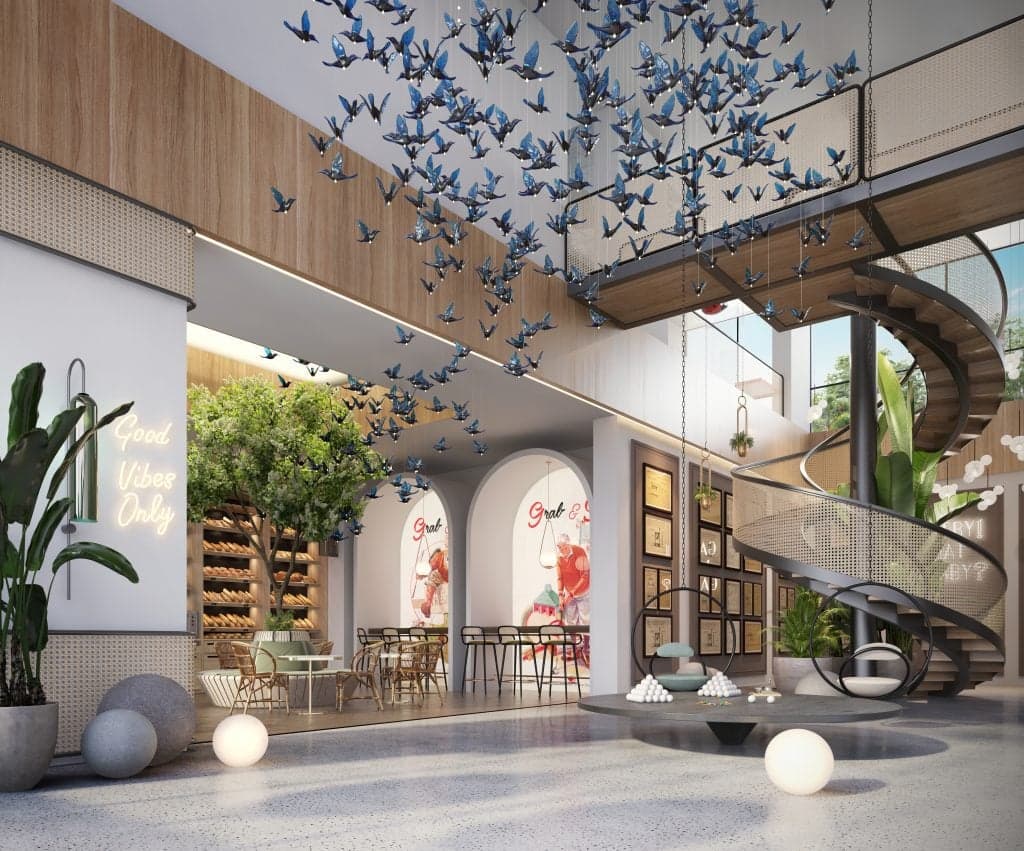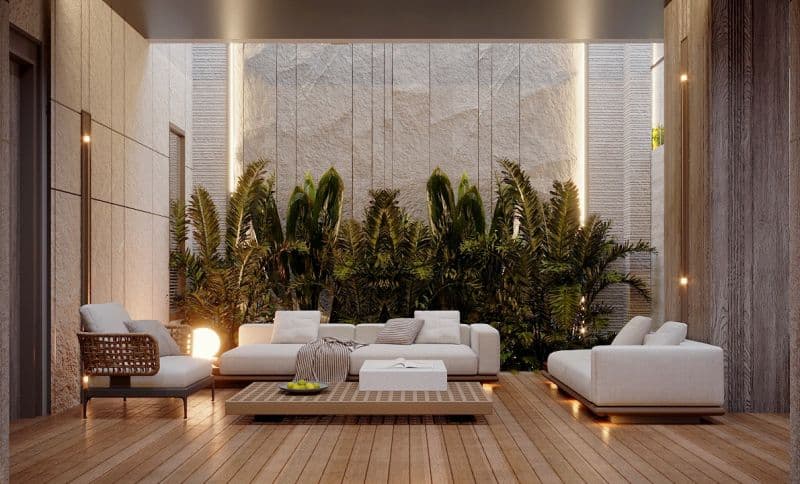
Creating Calm: How Architecture Shapes Emotional Well-Being?
Architecture transcends the mere creation of aesthetically pleasing structures; it is a profound influence on our emotional and psychological equilibrium. The design of spaces—where we live, work, and unwind—has a direct impact on our state of mind, shaping our responses to the environment. Every facet of architectural composition, from the selection of materials to the spatial arrangement, possesses the potential to significantly affect our mood and emotional well-being. This article delves into the intricate ways architecture can evoke emotional responses and examines its crucial role in the cultivation of our inner world.
The influence of the environment on emotions
Natural elements and their role
Nature profoundly influences our emotions, with elements like plants, water, sunlight, and air enhancing well-being. Integrating these into architecture promotes relaxation and reduces stress, creating a harmonious connection between the built environment and nature.
- Green spaces—such as parks and gardens—offer vital connections to nature, fostering stress relief and enhancing well-being. Proximity to these areas helps alleviate anxiety and depression, boosting mood and emotional health.
- Water: Water bodies and fountains evoke a sense of peace and relieve stress. The sound of water and its movement create an atmosphere of peace and harmony, positively affecting the psyche.
- Natural light elevates mood and energy, regulating hormones like serotonin and reducing stress. This is particularly vital during winter, when exposure to daylight can combat seasonal affective disorders.
Open and closed spaces
The design and layout of a room significantly shape our spatial perception and emotional state, influencing how we feel and interact with the environment.
- Open spaces, characterized by expansive, well-lit areas with high ceilings and ample windows, evoke a sense of freedom and tranquility, fostering comfort and enhancing confidence.
- Enclosed spaces, particularly those that are small or cramped, can induce discomfort and anxiety. Narrow corridors and low ceilings contribute to a feeling of confinement, heightening stress and unease.
- Balance between open and closed: The use of glass walls and terraces helps to connect interior spaces with the outside world, creating a sense of spaciousness without losing privacy.

The influence of materials on mood
The materials used in architecture are pivotal in shaping both the ambiance and emotional response within a space. Each material carries distinct associations, subtly influencing our perception and mood. Natural and eco-friendly materials, in particular, foster a warm, harmonious environment that encourages relaxation and alleviates stress.
- Wood: Warmth and coziness
Wood is associated with nature and comfort. It brings warmth and creates coziness, evoking positive emotions and promoting relaxation. Wooden elements in the interior, be it panels or furniture, make the space more natural and harmonious, creating an atmosphere of safety and tranquility.
- Stone: Stability and durability
Stone symbolizes stability and durability, which creates a sense of security and confidence. Stone surfaces bring a sense of solidity and grandeur, which helps people feel stable and secure in their surroundings.
- Metal and Glass: Modernity and Minimalism
Metal and glass create a modern, minimalist style and are associated with technology and progress. However, without a balance with warmer materials, they can be perceived as cold and sterile. Combining these materials with wood or textiles helps to create a cozy yet modern interior.
- Balance between materials
The fusion of diverse materials can craft a harmonious environment that is not only visually captivating but also conducive to comfort. For instance, the interplay of wood, stone, and glass strikes a balance between warmth and stability, while introducing elements of modernity and transparency. This synergy enhances mood and promotes relaxation, fostering a serene atmosphere.
Architecture as a tool of emotional control
The psychological impact of color
Color in architecture profoundly impacts both our emotional responses and spatial perception. Thoughtful color choices can craft the desired ambiance, aligning with and enhancing the emotional state, thereby shaping the overall atmosphere of a space.
- Blue promotes calm and relaxation, reducing stress. It’s ideal for bedrooms and relaxation areas.
- Green: Symbolizes harmony and freshness, helps to reduce stress. Suitable for offices and living spaces.
- Yellow: Activates mental activity, stimulates creativity and joy. Excellent for creative spaces.
- Red: Stimulates activity and attention, but in excess can cause tension. Good for active areas.
Proportion and shape
The proportions and shapes of buildings influence spatial perception. Harmonious forms evoke comfort and relaxation, while irregular shapes can induce discomfort and anxiety.
- Harmony of proportions: Correct proportions create balance and tranquility, enhancing emotional perception.
- Smooth lines: Organic shapes promote relaxation without causing tension.
- Sharp angles: Can cause discomfort and anxiety if used in excess.
How architecture affects productivity and relationships
Workspaces
The design of office and workspaces directly influences employee productivity and emotional well-being. Well-organized environments enhance focus, reduce stress, and foster a comfortable, efficient atmosphere.
- Natural light: Illuminated windows and sunlight improve mood, maintain energy levels and help regulate biorhythms. This not only promotes physical well-being but also increases productivity.
- Green plants in offices reduce stress, improve air quality, and create a pleasant atmosphere, enhancing focus and helping employees manage emotional stress.
- Spacious, open areas with flexible seating and mobile furniture foster creativity and collaboration. These environments prevent feelings of confinement, promoting freedom in communication and teamwork.
- Interactive areas: Work features such as meeting spaces and flexible negotiation areas improve interaction and strengthen teamwork.
Living spaces
The design of living spaces deeply influences residents’ emotional well-being and interpersonal relationships. Flexibility and adaptability are key, allowing spaces to foster comfort, security, and a sense of belonging.
- Flexibility and adaptability: Spaces that can be easily modified to suit personal preferences (e.g. open floor plans) create a sense of control over the environment, which increases satisfaction and peace of mind.
- Harmony and coziness: Harmonious proportions, the use of warm materials and well-designed interiors contribute to an atmosphere of comfort and security, which is important for strong and trusting family relationships.
- Privacy and common areas: The comfortable division of space between private areas and common areas promotes privacy while strengthening the bond between family members.
Finish
Architecture is a powerful weapon that can affect our mental and psycho-emotional states in addition to being the art of designing stunning and useful structures. Every element of a space, whether it’s the choice of materials, color or form, has an impact on our inner world, helping to reduce stress, enhance mood and create harmony. By designing new spaces, we not only shape the appearance of the world around us, but also influence how people will feel inside those spaces. Ultimately, architecture becomes not just a physical shelter, but a source of peace that promotes harmony between body and soul.